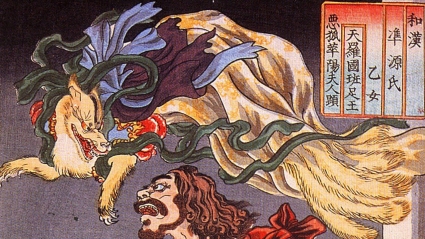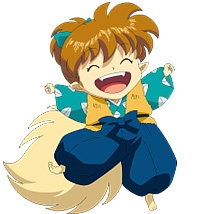
Cultural Notes
Kitsune
Demons
 Kitsune are considered to be clever, and selfish. Most of the stories about them concern "a lone woman found out in the woods. She is very beautiful, and begs for help. The man (usually a powerful lord, or a samurai) takes care of her. However, the woman turns out to be too beautiful and arrogant to be a mere human. Eventually, she is discovered to a be fox spirit, and chased away, or killed." The stories of fox-women seem to have originated in China, with the husband being the Chinese Emperor. The woman runs away to Japan, and resurfaces with a Japanese husband.
Kitsune are considered to be clever, and selfish. Most of the stories about them concern "a lone woman found out in the woods. She is very beautiful, and begs for help. The man (usually a powerful lord, or a samurai) takes care of her. However, the woman turns out to be too beautiful and arrogant to be a mere human. Eventually, she is discovered to a be fox spirit, and chased away, or killed." The stories of fox-women seem to have originated in China, with the husband being the Chinese Emperor. The woman runs away to Japan, and resurfaces with a Japanese husband.
Found throughout East Asian folklore are innumberable tales about the fox, an animal considered predisposed to magic and particularly prone to developing ghostly qualities. Like the tengu, foxes were both divine and mischievous beings, adept at shapeshifting and illusion and often accused of possessing and misleading humans.
The fox refines its talents over the years and acquires wisdom with age, and it was thought that a fox lucky enough to survive fifty or a hundred years would then be sufficiently skilled in magic to transform into a person. As a sign of its seniority, a long-lived fox would develop an extra tail with each passing century, until it possessed nine and had become impossibly powerful and clever.
Foxes were thought to live lives much like people, and in art they often interact with each other in a partially anthropomorphic form, standing on two legs and wearing clothes. But to enter the world of humans they had to look completely like them, as foxes caught trying to trick people with disguises would be severely punished, and often wound up in soup. A fox wishing to transform itsself had many special techniques at its disposal, such as placing a human skull on top of its head and praying to the Big Dipper. A careless fox might still leave elements of its anatomy unchanged beneath its clothes, usually a tail but sometimes fur and paws as well, and sometimes it was thus discovered.
 The most famous kitsune stories involve foxes that transform themselves into beautiful women, usually for devious purposes but sometimes out of love. Foxes in human form would even sometimes marry human men and have children, who would manifest their supernatural vulpine heritage in unusual strength, charisma, or spiritual power. Famous men such as the great onmyouji Abe no Seimei were often said to be the sons of fox wives.
The most famous kitsune stories involve foxes that transform themselves into beautiful women, usually for devious purposes but sometimes out of love. Foxes in human form would even sometimes marry human men and have children, who would manifest their supernatural vulpine heritage in unusual strength, charisma, or spiritual power. Famous men such as the great onmyouji Abe no Seimei were often said to be the sons of fox wives.
Foxes have also become very closely associated and even confused with the kami Inari, the ambiguously-gendered god/goddess of rice and the harvest, and are often thought to be his/her messengers or incarnations. Depictions of foxes have largely replaced anthropomorphic images of Inari at his/her many shrines, which are guarded by a pair of stone foxes instead of the usual Chinese lions. Offerings of abura-age (fried, sweetened tofu), thought to be a favorite of foxes, are often made to this kami.
Various ranks of foxes are said to exist; at the bottom is the yako or nogitsune, the ordinary, earthly "field fox", above that are the kiko (air or spirit fox), and the kuuko (sky or emptiness fox); and the highest of all is the tenko or amagitsune, the fox of heaven, sometimes considered to be the same being as the great tengu. The nogitsune, as the only kind of fox that does not serve Inari, is also the only type that can harm a human being, but these wild foxes can still sometimes reach their full nine-tailed potential, as in the tale of the wicked Tamamo-No-Mae, who through her deadliness and illusionary beauty became perhaps the most famous fox in all of Japanese folklore.
Relevance to Inuyasha
Of course, kitsune are represented very well in Inuyasha, as one of our heroes, Shippo is a fox demon. Upon first meeting Shippo, some of the more well-known historical traits of kitsune are visible in him, he is a clever trickster who attempts to steal Kagome's Shikon jewel shard and his use of fox magic throughout the series.